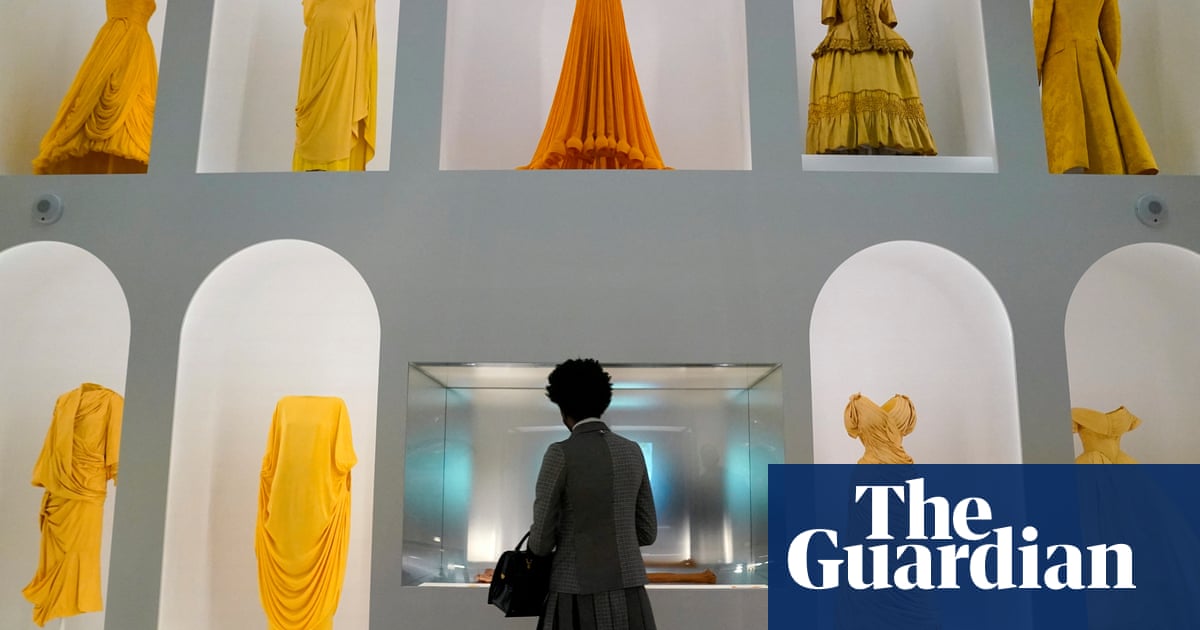The rustling of silk, the clattering of seashells and the sweet aroma of flowers. All these captivating effects, plus many more, are now beckoning visitors to the Metropolitan Museum of Art’s ambitious spring fashion exhibition.
Titled Sleeping Beauties: Reawakening Fashion, the show is an ode to the multisensory aspects of fashion, shifting focus to the evocative smells, sounds and textures of certain garments and accessories pulled from the museum’s collection. In an age when social media has flattened fashion to pixels on a screen, consider this the Met’s appeal to engage with it in the physical world.
“A painting is painted by an artist to look at, and it immediately sits on a wall for us to reflect on,” Max Hollein, the Met’s chief executive and president said in a media statement just hours before the Met Gala turned the museum’s front steps into the world’s most over-the-top red carpet. “A dress is made to be worn, to move in space. When a work of fashion enters into the Met’s collection, it becomes an object. You can no longer touch it, you can no longer feel it, not in the way the original creator intended. This exhibition is a grand multi-sensory experiment, and a celebration of the many dimensions of the fashion experience.”
That was the challenge to the show’s curator, Andrew Bolton, and his team, who have displayed 250 garments and accessories representing a period reaching back four centuries alongside 75 new acquisitions made for this show.
They have leveraged technologies old and new to conjure the sensorial experiences associated with the displayed pieces. Take the opening tableaux: a ballgown by the British couturier Charles Frederick Worth dating back to the 1880s, so delicate that it is laid out horizontally (in a position that leads the museum to call these delicate frocks “sleeping beauties”). Across from it is an animated 3D figurine, dancing in a version of the same garment.
“Fashion is a living organism that requires most of our senses for its fullest appreciation and a greatest understanding,” Bolton said during the morning remarks. “Fashion elicits the senses of touch, smell, hearing and sometimes even taste. Except for sight, which is actually enhanced and amplified in a museum context, all our other senses are diminished or compromised. What was once a vital part of our lived experience becomes a lifeless work of art.”
His team uses clever techniques to give new life to these objects. A room dedicated to the daring style of the New York socialite Millicent Rogers features a fragrance meant to recall her scent derived from molecules found on the displayed dresses and hats. Hints of her perfume are mixed with recreated fragments of her natural body odors, affected by what she ate, drank and smoked.
The swishing of silk taffeta (known as “scroop”) can be heard beside a display of grand gowns. Then there’s the clanking of seashell paillettes next to a sleeveless Alexander McQueen sheath dress.
The exhibition is organised by themes of nature: flowers, insects, birds, the sea and so on. While the two overlapping ideas – the sensory experience and the natural world – can be confusing at times, the artistry and craftsmanship of the displayed objects act as a throughline. A large portion is dedicated to flowers, for instance: from the blurry digital floral print on a Loewe dress to an embroidered Yves Saint Laurent couture jacket inspired by Van Gogh’s Irises.
In other rooms there are McQueen dresses that look as though they have been made from butterfly wings and Dries Van Noten designs that appear to be festooned with iridescent beetle wings. Two dresses by the Irish designer Richard Malone look like ocean swells cocooning the body, while a navy wool coat from Jonathan Anderson of the Spanish label Loewe (a sponsor of this year’s show), made in collaboration with the biodesigner Paula Ulargui, features live grass growing on its front which will ultimately wilt and die, in a nod to fashion’s love of the ephemeral.
The final gallery contains a streamlined yet dramatic wedding gown that the socialite Natalie Potter wore to her wedding in 1930, complete with a scalloped train that unfurls over many steps. The mannequin is accompanied by a custom AI chatbot, designed by OpenAI, primed to answer questions about Potter and her life.
There is much to enjoy in the show, from the deteriorating gowns rarely seen in public, to the innovative designs from more contemporary designers, to the premise itself – that fashion is, ultimately, the most human of design endeavours, dependent on its interaction with the human body. It’s a sentiment echoed by Bolton. “The exhibition is a reminder that the museum garments, despite being destined for an eternal slumber, do not forget their sensorial histories,” he said. “Instead, these histories are embedded within the very fibers of their being, and simply require reactivation through the mind and body, heart and soul, of those willing to believe in the magic.”
-
Sleeping Beauties: Reawakening Fashion runs from 10 May to 2 September at the Metropolitan Museum of Art, New York (metmuseum.org)

